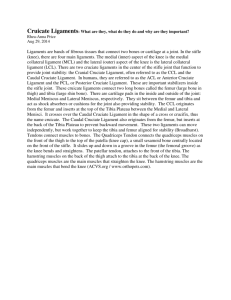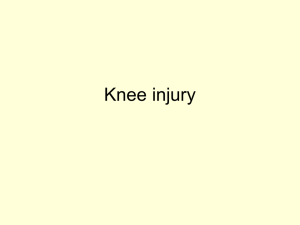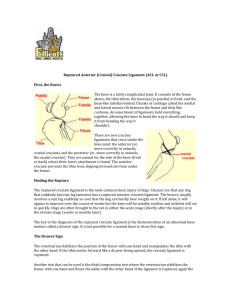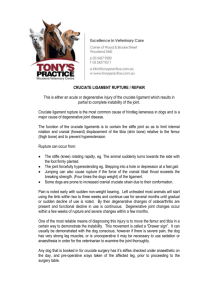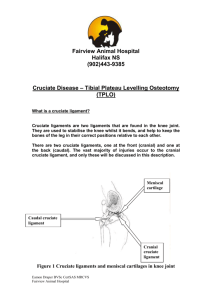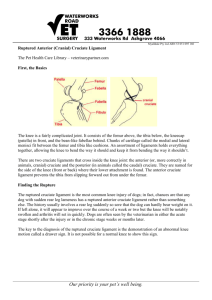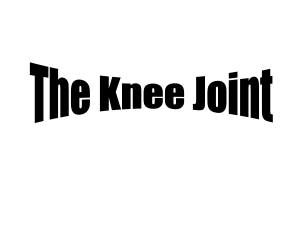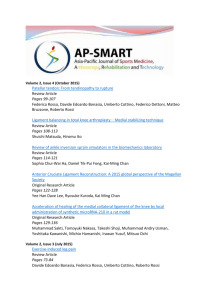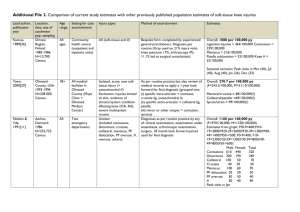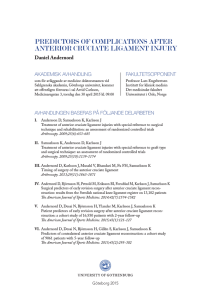CCL-ACL injuries powerpoint
advertisement
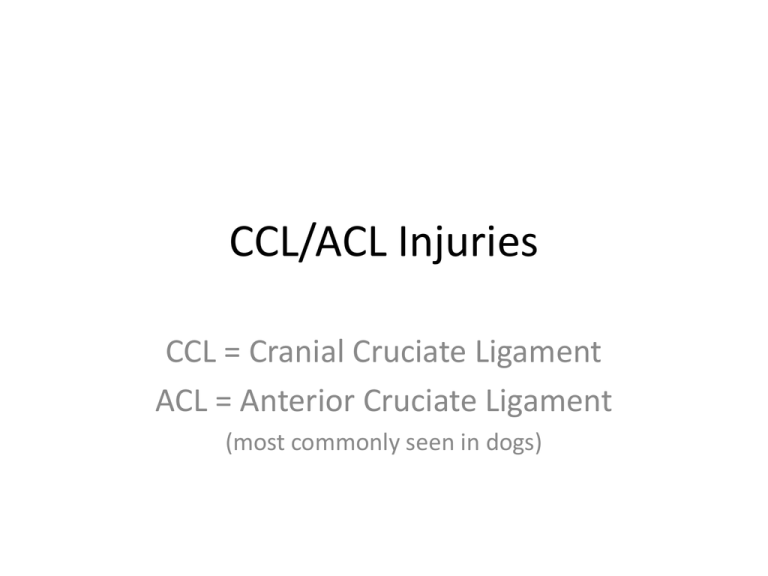
CCL/ACL Injuries CCL = Cranial Cruciate Ligament ACL = Anterior Cruciate Ligament (most commonly seen in dogs) What is the ACL/CCL? • It’s one of the two ligaments connecting the femur and tibia bones. • These ligaments are there to keep the bones from rubbing across each other. How does the injury occur? • Specifically – the knee twists too much and the ligament ruptures. – Examples: • Slipping on a floor • Excessive running • Trauma (i.e. hit by car) • Degeneration of the ligament • Obesity Breeds Affected • These breeds are seen to have increased risk of degeneration. – – – – – – – Labrador Retriever Newfoundland Rottweiler Bichon Frise St. Bernard Boxer West Highland White Terrior • Remember: ANY dog can rupture their ACL/CCL • Most that are predisposed will get it in both knees. • In small breeds, a luxating patella may predispose them. Symptoms of these injuries • Variable lameness on one or both hind feet • Lameness in affected limb (especially after exercise) that gets better with rest • Abnormal posture • Reluctance to run, jump, or rise from sleep. • Morning stiffness • When sitting, one leg sticks out to one side • Swelling around the knee joint • Slight deterioration of the muscles on the affected limb *If symptoms are very minor, it may be because of slight deterioration. How is it diagnosed? By watching and touching the animal. • Veterinarian views a limp with paw slightly touching the ground – Dog will not put any weight on the affected foot. With Radiography • Only used to access the amount of arthritis present in the knee joint. • Veterinarian manipulates the affected knee feeling for ‘drawer movement’ – The movement of the femur across the tibia • This is the only way to confirm the presence of rupture. • • http://www.youtube.com/watch?v=9jg9E2nBt_E Picture taken from University of Liverpool website How X-rays are used for this injury • Important because they will help evaluate the secondary conditions – Osteoarthritis – Joint cartilage injury – Accumulation of fluid around the joint. Picture taken from University of Liverpool website. X-ray technique: • Area that x-ray is taken at to get view of ACL/CCL = the stifle/knee joint • Best view is lateral but CaCr also necessary. • Measurement taken at the area of the widest part of stifle joint. • Beam centered over the stifle joint. • Veterinarian will measure the slope of the tibia to help choose which surgery to do How to fix this injury… • Surgery is the best most definitive option for medium to large size dogs. • There are various types of surgery. • Surgery will correct the ligament problem only • Majority of the time will also have to treat the accompanying issues – Arthritis – Joint fluid • But these problems may not happen for years. • Nylon bands can be used to correct a small dog’s rupture. • Some claim restricted activity for a long period of time after diagnosis will allow the joint to realign itself. Surgical Correction Options • 1. TPLO – Tibial Plateau Leveling Osteotomy – Most recommended for large breed dogs. – Procedure: • Surgeon checks the cartilage of the knee to determine if it is also torn • There is a cut made into the plateau of the tibia • It is rotated to make the slope more level with the femur • A plate and screws are inserted to make sure that it stays in place. – Much of the success of this option depends on the owners post-op care. TPLO – before and after x-rays Surgical Correction Options • 2. TTA – Tibial Tuberosity Advancement – a slightly less invasive procedure with slightly quicker recovery time – Results very similar to the TPLO option – Procedure: • Cut is made into the front part of the tibia (the tuberosity) • This part is pushed forward to remove the abnormal sliding of the bone • A specialized bone spacer in placed in the space that was created. Plate and screws also used to secure the bone in place. TTA – x-rays post surgery. Nylon Band Treatment • Most commonly used in small dogs and cats • A suture material made of nylon is passed between the back of the femur to the tibia crest • Scar tissue develops over time to stabilize the joint Prognosis? • With proper care, animal will return to regular activity. • Will most likely need to be on NSAIDs for the osterarthritis. • If only one side was affected/corrected the other one is more likely to eventually rupture Sources: • Degner, Daniel DACVS. “Cranial Cruciate Ligament Rupture – Lateral Fabellar Technique (Extrascapular Technique).” Vet Surgery Central Inc. 8 September 2010. http://www.vetsurgerycentral.com/cruciatelrt.htm. • Degner, Daniel DACVS. “Tibial Plateau Leveling Osteotomy.” Vet Surgery Central Inc. 8 September 2010. http://www.vetsurgerycentral.com/tplo.htm. • Degner, Daniel DACVS. “TTA for Cranial Cruciate Ligament Rupture in Dogs.” Vet Surgery Central Inc. 8 September 2010. http://www.vetsurgerycentral.com/ortho_TTA.htm. • Innes, John RCVS. “Cruciate Ligament Rupture.” University of Liverpool Small Animal Teaching Hospital. 8 September 2010. http://www.liv.ac.uk/sath/conditions/cruciate.htm. • Nash, Holly DVM, MS. “Ruptured Anterior Cruciate Ligament.” Pet Education.com. Doctors Foster and Smith. 8 September 2010. http://www.peteducation.com/article.cfm?c=2+2084&aid=474.
